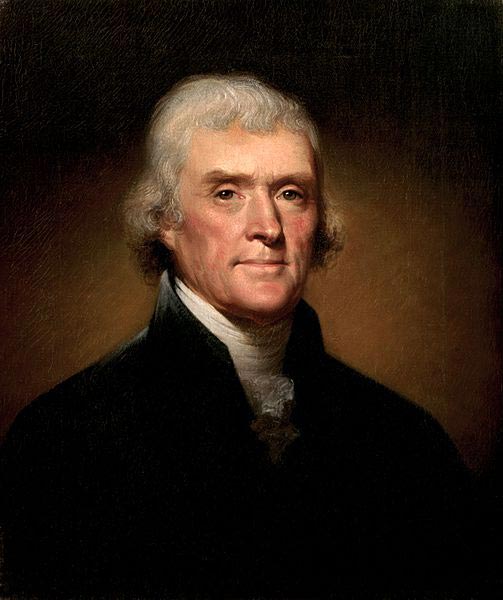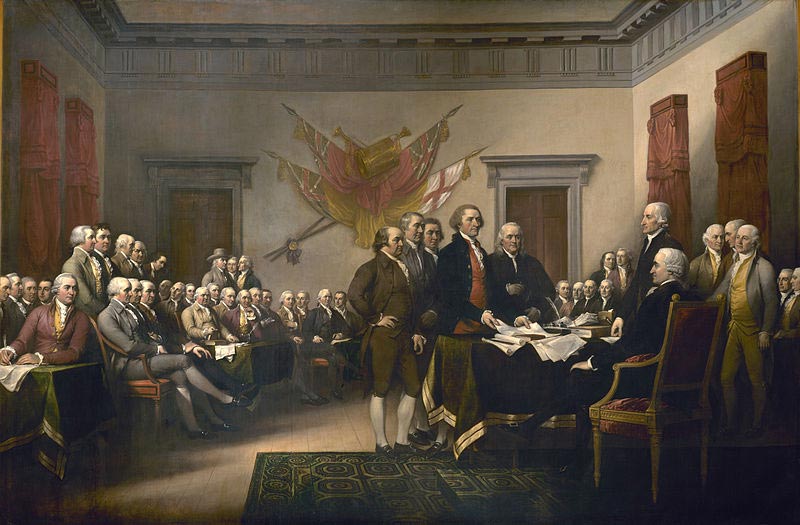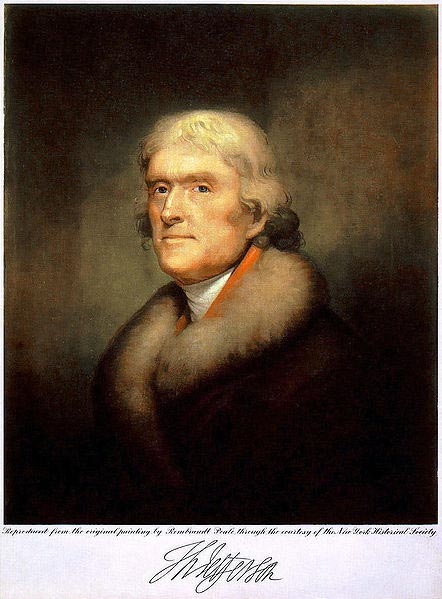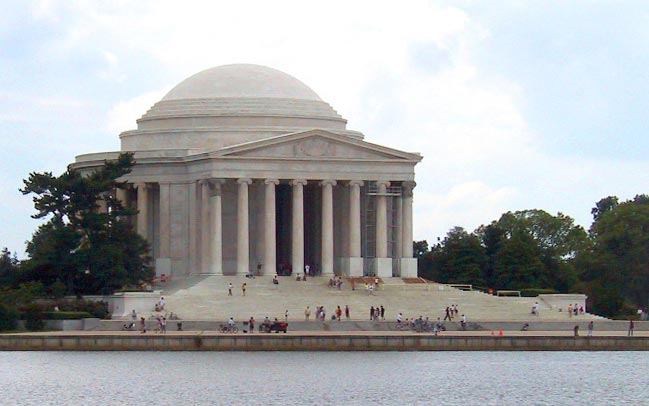| Thomas Jefferson | |
|---|---|
 |
|
| 3rd United States President « Previous Next » |
|
| In office | Mar. 4, 1801 – Mar. 4, 1809 |
| V. President | Aaron Burr |
| George Clinton | |
| Political Party | Democratic-Republican |
| Personal Info | |
| Born | Apr. 13, 1743 |
| Died | July 4, 1826 (at age 83) |
| Religion | Unknown |
| School | College of William and Mary |
| Profession | Planter |
| Signature | |
| Wife | Martha Wayles Jefferson |
| Children | Martha Jefferson Randolph, Jane Randolph, Mary Jefferson Eppes, Lucy Elizabeth, Lucy Elizabeth (2nd Lucy) |
| U.S. Presidents 1-15 | |
| 1. George Washington (1789–1797) | |
| 2. John Adams (1797-1801) | |
| 3. Thomas Jefferson (1801-1809) | |
| 4. James Madison (1809-1817) | |
| 5. James Monroe (1817-1825) | |
| 6. John Quincy Adams (1825-1829) | |
| 7. Andrew Jackson (1829-1837) | |
| 8. Martin Van Buren (1837-1841) | |
| 9. William Henry Harrison (1841-1841) | |
| 10. John Tyler (1841-1845) | |
| 11. James Knox Polk (1845-1849) | |
| 12. Zachary Taylor (1849-1850) | |
| 13. Millard Fillmore (1850-1853) | |
| 14. Franklin Pierce (1853-1857) | |
| 15. James Buchanan (1857-1861) | |
| List of All the Presidents |
Thomas Jefferson, third president (1801 –1809) of the United States of America, was one of her Founding Fathers and a principal author of the Declaration of Independence.
Early Life
Using the Gregorian calendar as the basis of determining birth, Apr. 13, 1743 was designated as the day Thomas Jefferson was born in Shadwell, then Edge Hill in Goochland (now Albemarle County), Virginia, into the Randolph family. His father, Peter Jefferson, believed to be of Welsh descent, was a surveyor and a planter of 5,000 acres of land which upon his death, was inherited by the young Jefferson at the age of 14 including the slaves. He studied mathematics, philosophy and metaphysics when he attended the College of William and Mary in Williamsburg from 1760-1762 at the age of 17 and met his influential mentor, law professor George Wythe. He indulged himself in reading French, Greek and Latin classics, and playing violin. He spoke five languages, collected books and wrote more than sixteen thousand letters. Jefferson graduated with highest honors in 1762. He later worked as a law clerk for Wythe during which stint he continuously read law and a variety of political works, and five years later in 1767, he was admitted to the Virginia bar. As a lawyer, he handled many cases of his clients from Virginia’s elite families, including the Randolph family.
At 26, he was elected to the Virginia House of Burgesses in 1769 and the following year, began building a neo-classical mansion, Monticello at the mountaintop which he had always wanted to do since childhood based primarily on the works of architect Andrea Palladio and his study on classical orders. As a delegate to the house, he wrote various resolutions against the Coercive Acts passed by the British Parliament in 1774. He argued that the authority of the British Parliament was confined only to Great Britain and does not encompass the colonies and that the colonists had the natural right to govern themselves. His first published work, A Summary View of the Right of the British America, was intended to serve as instructions for Virginia’s delegation to the First Continental Congress.
Jefferson married a wealthy 23-year old widow Martha Wayles Skelton in 1772 at age 29 and the couple had six children: (1) Martha Washington Jefferson (1772-1836); (2) Jane Jefferson (1774-1775); (3) stillborn or unnamed son (1777); (4) Mary Wayles Jefferson (1778-1804); (5) Lucy Elizabeth (1780-1781); and (6) Lucy Elizabeth (1782-1785). Of the six only Martha, the oldest daughter lived beyond age 25 and together with Mary Wayles survived to adulthood.
Political Affairs
 He became active in party politics when he helped organized the Committee of Correspondence for Virginia on March 12, 1773 composed of eleven members including himself. The committee was tasked to disseminate information regarding British actions on the eve of American Revolution. In June 1775 at age 32 he was elected as delegate to the 2nd Continental Congress soon after the Revolutionary War had begun and was appointed to a five-man committee created to prepare a Declaration of Independence for submission to the congress which ratified the final draft on July 4, 1776 two days after approving the accompanying resolution. It was said that during the 3-day debate Jefferson spoke not a word for or against the draft declaration. The preamble of the declaration became a lasting statement of human rights and the declaration itself, Jefferson’s major claim to fame.
He became active in party politics when he helped organized the Committee of Correspondence for Virginia on March 12, 1773 composed of eleven members including himself. The committee was tasked to disseminate information regarding British actions on the eve of American Revolution. In June 1775 at age 32 he was elected as delegate to the 2nd Continental Congress soon after the Revolutionary War had begun and was appointed to a five-man committee created to prepare a Declaration of Independence for submission to the congress which ratified the final draft on July 4, 1776 two days after approving the accompanying resolution. It was said that during the 3-day debate Jefferson spoke not a word for or against the draft declaration. The preamble of the declaration became a lasting statement of human rights and the declaration itself, Jefferson’s major claim to fame.
Jefferson was elected as member of the Virginia House of Delegates in September 1776 serving for three years (1776-79) during which period he introduced reforms to update Virginia’s system of laws and judiciary. He attempted to eliminate capital punishment for all crimes except murder and treason and repeal of the death penalty law but was defeated.
When the Second Continental Congress adjourned, he returned to Virginia and was elected governor in 1779 at the age of thirty-six, succeeding Patrick Henry. He was re-elected in 1780 but resigned in 1781 after Virginia was invaded by British troops and burned the capital city of Richmond for which he was criticized. A British secret expedition to capture him was thwarted by a heroic action of Jack Jouett of the Virginia militia enabling Jefferson and his entourage to escape unnoticed. During his term as Governor he wrote the statute on religious freedom (enacted in 1786), transferred the capital to Richmond from Williamsburg and instituted reforms at the William and Mary College including the appointment of George Wythe as the professor of law and the adoption of an honor code.
After his wife’s death in 1782 Jefferson again became a delegate to the Congress albeit mourning, and in 1784 he drafted the report that was the basis for the Ordinances of 1784, 1785, and 1787. He was minister to France from 1785 to 1789, when George Washington appointed him secretary of state. As Minister to France he sympathized with the French Revolution. As Secretary of State (1790-1793) he argued over the funding of the debts of the war and other fiscal policies with Alexander Hamilton comparing him and the Federalists with “Royalism”. He supported France against Britain during the conflict in 1793 believing that the success of the French Army would facilitate political success at home. When he retired to Monticello in 1793 Jefferson continued to oppose Hamilton’s policies and praised the French revolution which he refused to disavow even during the violence of the Reign of Terror. Jefferson’s strong faith in the consent of the governed conflicted with the emphasis on executive control espoused by Secretary of the Treasury Alexander Hamilton, and he resigned on Dec. 31, 1793.
The Election of 1796
Due to political differences and developments of sharp conflicts, two separate political parties began to form, the Democratic-Republicans and the Federalists. The Republicans, headed by Jefferson, attacked Federalist policies, sympathized with France’s revolutionary cause and opposed strong centralized government. In the 1796 presidential election Jefferson was the Democratic-Republican candidate for president; John Adams won the election, and Jefferson became vice president through a flaw in the Constitution which caused a more serious problem. As presiding officer of the Senate, he was concerned about the absence of rules governing its proceedings.
The Election of 1800
 In 1800, Jefferson and Aaron Burr received equal Electoral College votes; the House of Representatives elected Jefferson president. He took the oath of office on March 4, 1801 before Chief Justice John Marshall at the new capital in Washington, D.C., a time when partisan strife was growing. Jefferson was a strong advocate of westward expansion; major events of his first term were the Louisiana Purchase (1803), the winning of the first U.S. war overseas (Barbary War) and the Lewis and Clark expedition. He slashed army and navy expenditures, eliminated the tax on whiskey and cut the budget.
In 1800, Jefferson and Aaron Burr received equal Electoral College votes; the House of Representatives elected Jefferson president. He took the oath of office on March 4, 1801 before Chief Justice John Marshall at the new capital in Washington, D.C., a time when partisan strife was growing. Jefferson was a strong advocate of westward expansion; major events of his first term were the Louisiana Purchase (1803), the winning of the first U.S. war overseas (Barbary War) and the Lewis and Clark expedition. He slashed army and navy expenditures, eliminated the tax on whiskey and cut the budget.
The Barbary War
The Barbary War was a result of Jefferson’s refusal to pay tribute or bribe to Barbary States for the protection of American ships against North African piracy favoring instead fighting the pirates than paying the bribe. The Barbary pirates were harassing American commerce in the Mediterranean. The Louisiana Territory was sold by Napoleon of France to the United States for $15 million in 1803 thus doubling the size of the United States. The constitutionality of the acquisition had never been raised. Napoleon believed he could no longer defend the French territory in America and was facing imminent war against Britain. France was also facing bankruptcy.
The Lewis and Clark Expedition and Westward Expansion
In 1804 the Lewis and Clark Expedition (1804-1806) consisting of 45 men and led by Meriwether Lewis and William Clark was sent by Jefferson to explore the new (Louisiana) territory (and beyond), open the American west to settlement and for scientific and geographical data purposes including finding a “direct & practicable water communication across the continent, for the purposes of commerce”. The expedition reached the Pacific Ocean by November 1805 and provided information concerning the topographical features and the natural resources, as well as the Indian tribes. The president also signed the Military Peace Establishment Act on March 16, 1802 which directed the establishment of corps of engineers to be stationed at West Point in the state of New York and to be constituted as the U.S. Military Academy. The scientific and military learning institution formally commenced on July 4, 1802. Other first-term accomplishments include: (1) pardoned people imprisoned under the Alien and Sedition Acts; (2) signed into law segregating the U.S. postal system by forbidding blacks to carry mail; (3) repealed the Judiciary Act of 1801; and (4) repealed federal taxes in favor of customs revenue.
The Embargo Act
An important development during his second term was the passage of the Embargo Act, barring U.S. ships from setting sail to foreign ports. Jefferson established the University of Virginia and designed its buildings. He ordered his former vice president Aaron Burr tried for treason in 1807 but was acquitted. He was increasingly preoccupied with keeping the nation from involvement in the Napoleonic wars. The Embargo Act was promulgated to restrict American ships from engaging in foreign trade between the years 1807 and 1812, which led to the War of 1812 between the U.S. and Britain. It was repealed by Congress at the end of Jefferson’s second term for being unpopular. The Act Prohibiting Importation of Slaves was signed into law and went into effect January 1, 1808, stating that no new slaves were permitted to be imported into the United States effectively ending the legal transatlantic slave trade or “piracy” of slaves. His public and private positions on slavery failed to convince historians of its proper interpretations specially when he declared his opposition to slavery as an institution and wanted to end it but personally depended on enslaved labor to support his household and plantations.
Life After Presidency
Jefferson founded the University of Virginia in 1819 a few years after leaving the Presidency. A full slate of elective courses were offered within that ensemble of buildings and ground which innovative architectural design was both inspired by him and viewed as an expression of his aspirations for both state-sponsored education and an agrarian democracy. It was designed as the capstone of Virginia’s educational system.
After he became a widow at age 40, his health deteriorated by July 1825 and was bedridden since then. He died from uremia, severe diarrhea and pneumonia on July 4, 1826, on the same day as John Adams (the 50th anniversary of the Declaration of Independence). All his possessions, including his slaves and Monticello were sold in consequence of his financial debts in 1831. He was buried at the family cemetery at Monticello.
Analysis of DNA taken from descendants of Jefferson and Sally Hemings, one of his slaves of mixed-race, revealed a very high probability of Jefferson fathering at least one, perhaps all, of her six known children. The 38-year intimate relationship with Sally and the Hemingses would have been called a “shadow family”. However, most biographers publicly stated their being convinced of Jefferson’s paternity of Hemings’ children and the Thomas Jefferson Foundation issued a report in 2000 supporting Jefferson’s paternity. In 1998 a DNA study showed a genetic match between the Hemings descendant and the Jefferson line.
Jefferson’s Accomplishments and Inventions
Jefferson was a farmer with tobacco as his main cash crop. He was also an inventor with samples include the design for a revolving bookstand to hold five volumes at once, the “Great Clock, and helped improve the polygraph and moldboard plow. He helped popularize the Neo-Palladian architectural style in the United States and advocated the growing and smoking of hemp. As a republican, his vision was that of an agricultural nation of independent and civic-conscious farmers. He distrusted and disliked banks and bankers in opposition to borrowing. While he believed that each man has “certain inalienable rights”, he did not support gender equality and opposed female involvement in politics. He was known as the “agrarian democrat” who shaped the thinking of his nation. His religious views were considered varied in practice and belief. He opposed orthodox Christianity, remained hostile to the Catholic Church and embraced Unitarianism as a belief and the religious philosophy of Deism. He held to the view that God was a material being.
